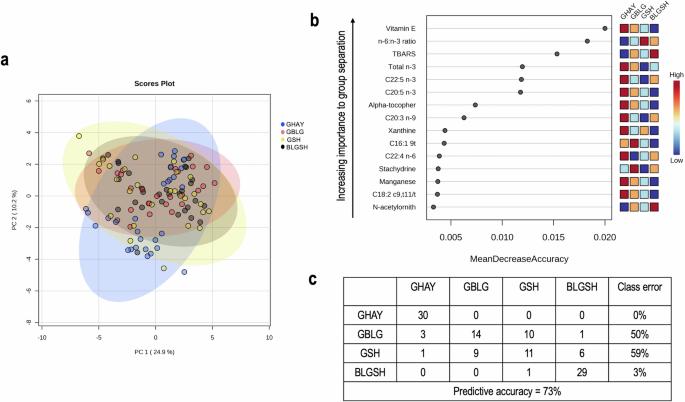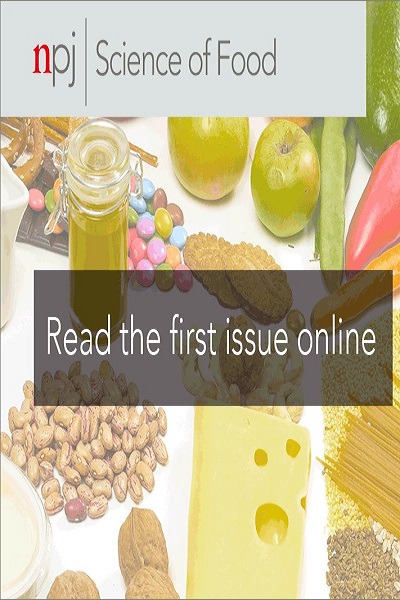Fatty acids and secondary metabolites can predict grass-finished beef and supplemental cattle feeds
IF 6.3
1区 农林科学
Q1 FOOD SCIENCE & TECHNOLOGY
引用次数: 0
Abstract
Beef raised using rotational grazing practices on biodiverse pastures offers potential benefits to animal and environmental health and can improve the nutrient density of meat to favor human health. However, many cattle producers contend with the seasonal unavailability of fresh forage, necessitating the utilization of supplementary feeds or indoor feeding. The objective of this study was to profile secondary metabolites and fatty acids in grass-finished beef supplemented with different feeds (4.5 kg/head/day) and to explore the potential for grass-finished beef authentication. In this two-year study, steers (n = 115) were randomly allocated to one of four diets: 1) pastured/supplemented with hay (control group), 2) pastured/supplemented with baleage, 3) pastured/supplemented with soybean hulls, or 4) baleage/soybean hulls in confinement. Secondary metabolites and fatty acids were measured using UHPLC-MS/MS and GC-MS, respectively. Of the 94 measured metabolites, pyridoxine, alpha-tocopherol, hippuric acid, and gallic acid differed between diets (p < 0.05 for all). Based on random forest classification, beef from the pasture/hay, pasture/baleage, pasture/soybean hulls, and confinement baleage/soybean hulls groups could be identified with a predictive accuracy of 100%, 50%, 41%, and 97%, respectively. Although minimal significant differences were observed, our data indicate that certain supplemental feeds maintain favorable nutritional profiles of grass-finished beef. In addition, metabolomics can predict cattle on exclusively forage-based or feed-based diets with a high degree of certainty.

脂肪酸和次生代谢物可预测草饲牛肉和牛的补充饲料。
在生物多样性牧场上采用轮牧方式饲养牛肉,可为动物和环境健康带来潜在益处,并能提高肉类营养密度,有利于人类健康。然而,许多养牛者都面临着新鲜牧草季节性供应不足的问题,因此必须使用补充饲料或进行室内饲养。本研究的目的是分析添加不同饲料(4.5 千克/头/天)的草制牛肉中的次生代谢物和脂肪酸,并探索草制牛肉认证的潜力。在这项为期两年的研究中,将小公牛(n = 115)随机分配到四种日粮中的一种:1)放牧/补充干草(对照组);2)放牧/补充草捆;3)放牧/补充豆壳;或 4)圈养草捆/豆壳。次生代谢物和脂肪酸分别采用超高效液相色谱-质谱/质谱法和气相色谱-质谱法进行测定。在测得的 94 种代谢物中,吡哆醇、α-生育酚、马尿酸和没食子酸在不同日粮之间存在差异(p<0.05)。
本文章由计算机程序翻译,如有差异,请以英文原文为准。
求助全文
约1分钟内获得全文
求助全文
来源期刊

NPJ Science of Food
FOOD SCIENCE & TECHNOLOGY-
CiteScore
7.50
自引率
1.60%
发文量
53
期刊介绍:
npj Science of Food is an online-only and open access journal publishes high-quality, high-impact papers related to food safety, security, integrated production, processing and packaging, the changes and interactions of food components, and the influence on health and wellness properties of food. The journal will support fundamental studies that advance the science of food beyond the classic focus on processing, thereby addressing basic inquiries around food from the public and industry. It will also support research that might result in innovation of technologies and products that are public-friendly while promoting the United Nations sustainable development goals.
 求助内容:
求助内容: 应助结果提醒方式:
应助结果提醒方式:


